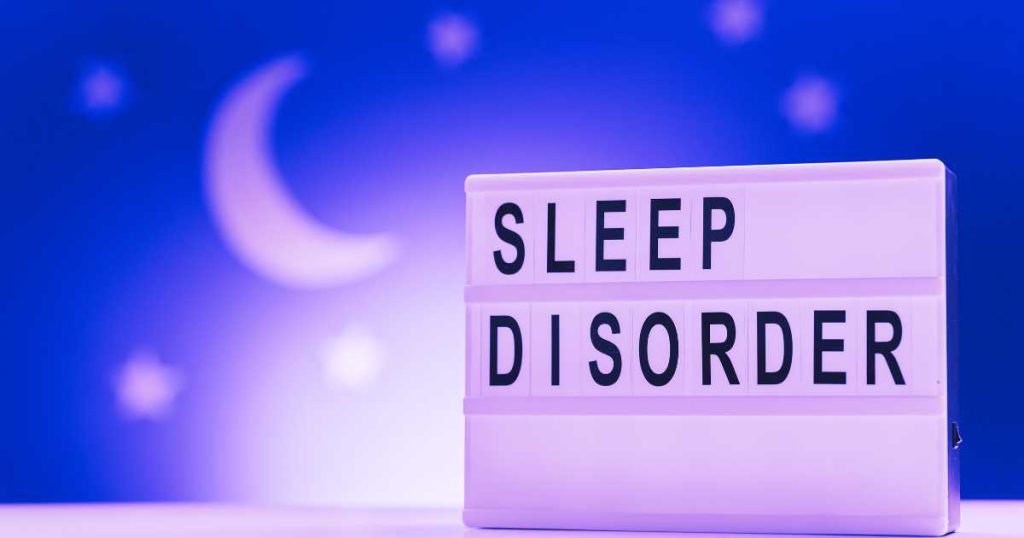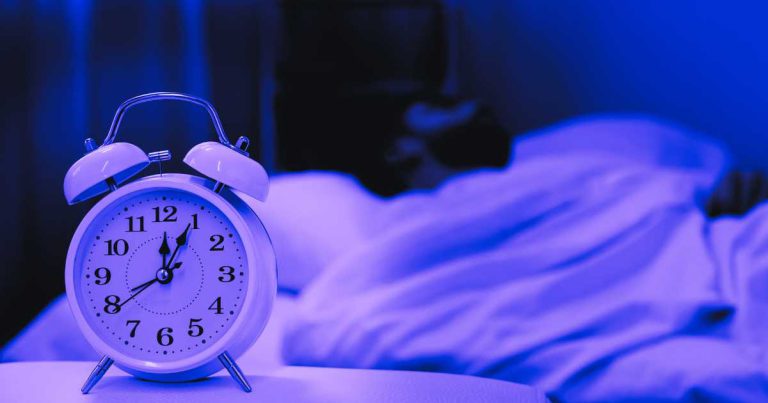Sleep disorders can significantly alter the content, frequency, and emotional tone of dreams. Insomnia, sleep apnea, and narcolepsy are among the most common sleep disorders that affect dreaming.

Sleep disorders not only affect the quality and quantity of sleep but also have a profound impact on the content and frequency of dreams.
Key Takeaways:
- Sleep disorders can significantly alter the content, frequency, and emotional tone of dreams.
- Insomnia, sleep apnea, and narcolepsy are among the most common sleep disorders that affect dreaming.
- Nightmares and lucid dreams are more prevalent in individuals with sleep disorders.
- Treating underlying sleep disorders can help improve sleep quality and normalize dream experiences.
The Science of Sleep and Dreaming
To understand how sleep disorders impact dreaming, it’s essential to grasp the basics of sleep science. Sleep is divided into two main stages: non-rapid eye movement (NREM) and rapid eye movement (REM) sleep.
NREM sleep consists of three stages, each characterized by progressively slower brain waves. REM sleep, on the other hand, is marked by heightened brain activity, similar to that of wakefulness, and is the stage most closely associated with vivid dreaming [1].
During a typical night’s sleep, we cycle through these stages multiple times, with REM periods becoming longer and more frequent towards the end of the night. While dreaming can occur in any stage, the most memorable and emotionally charged dreams tend to happen during REM sleep [1].
Sleep Stage | Characteristics Get free Dream Interpretation by using our Dream App | Dream Occurrence |
|---|---|---|
NREM Stage 1 | Light sleep, easily awakened | Rare, fragmented dreams |
NREM Stage 2 | Deeper sleep, slower brain waves | Occasional, less vivid dreams |
NREM Stage 3 | Deepest sleep, slow brain waves | Rare, abstract dreams |
REM Sleep | Heightened brain activity, paralysis | Frequent, vivid, emotional dreams |
Common Sleep Disorders and Their Impact on Dreaming
Several sleep disorders can significantly alter the dream experience, both in terms of content and frequency. Let’s explore some of the most prevalent sleep disorders and their effects on dreaming.
Insomnia
Insomnia is a sleep disorder characterized by difficulty falling asleep, staying asleep, or both, despite having adequate time and opportunity for sleep [2]. People with insomnia often report:
- Increased dream recall
- More negative and distressing dream content
- Frequent nightmares
The heightened dream recall in insomnia may be due to the increased number of awakenings throughout the night, which allows for better memory consolidation of dream experiences [3]. Additionally, the stress and anxiety associated with insomnia can manifest in dreams, leading to more negative and emotionally charged content [4].
Sleep Apnea
Sleep apnea is a disorder in which breathing repeatedly stops and starts during sleep, leading to fragmented sleep and reduced oxygen levels in the body [5]. People with sleep apnea may experience:
- Decreased dream recall
- More aggressive dream content
- Dreams related to suffocation or drowning
The reduced dream recall in sleep apnea may be attributed to the frequent arousals and disrupted sleep architecture, which interfere with the consolidation of dream memories [6]. When dreams are remembered, they often reflect the physical sensations of struggling to breathe, resulting in themes of suffocation or drowning [7].
Narcolepsy
Narcolepsy is a neurological disorder characterized by excessive daytime sleepiness and sudden sleep attacks [8]. People with narcolepsy often experience:
- Vivid, intense dreams
- Hypnagogic hallucinations (dreamlike experiences while falling asleep)
- Sleep paralysis (inability to move upon waking)
- Lucid dreaming (awareness of being in a dream)
The abnormal REM sleep patterns in narcolepsy, such as entering REM sleep quickly and experiencing fragmented REM periods throughout the day, contribute to the heightened dream experiences [9]. Lucid dreaming, in particular, is more common in individuals with narcolepsy, possibly due to the blurred boundaries between wakefulness and REM sleep [10].
The Prevalence of Nightmares and Lucid Dreams
Nightmares and lucid dreams are two distinct dream experiences that are more common among individuals with sleep disorders.
Nightmares
Nightmares are vivid, disturbing dreams that often cause feelings of fear, anxiety, or terror. They can be triggered by stress, trauma, or certain medications, and are more prevalent in people with sleep disorders [11]. In fact, up to 80% of individuals with insomnia report experiencing nightmares [12].
Nightmares can have a significant impact on sleep quality and daytime functioning. They may lead to:
- Sleep avoidance or fear of falling asleep
- Daytime fatigue and sleepiness
- Mood disturbances, such as anxiety or depression
- Impaired cognitive function and memory
Treatment for nightmares often involves a combination of therapy, such as cognitive-behavioral therapy for insomnia (CBT-I) or imagery rehearsal therapy (IRT), and medication, such as prazosin or certain antidepressants [13].
Lucid Dreams
Lucid dreams are dreams in which the dreamer becomes aware that they are dreaming and may even be able to control the dream content. While lucid dreaming can occur spontaneously, it is more common in individuals with sleep disorders, particularly narcolepsy [14].
Lucid dreaming has been associated with both positive and negative effects on sleep and well-being. On the positive side, lucid dreaming can:
- Provide a sense of control and mastery over dream content
- Allow for creative problem-solving and skill rehearsal
- Reduce the frequency and intensity of nightmares
However, lucid dreaming can also:
- Disrupt sleep architecture and reduce sleep quality
- Lead to sleep paralysis or false awakenings (dreams of waking up)
- Cause feelings of dissociation or derealization
While there is no specific treatment for lucid dreaming, practicing good sleep hygiene and managing underlying sleep disorders can help normalize dream experiences.
The Role of Sleep Disorders in Dream Content
In addition to altering the frequency and intensity of dreams, sleep disorders can also influence the content of dreams. Dreams are thought to reflect our waking experiences, emotions, and concerns, and this is particularly true for individuals with sleep disorders.
For example, people with insomnia often report dreams that mirror their waking struggles, such as dreams of being unable to fall asleep or feeling exhausted [15]. Similarly, individuals with sleep apnea may have dreams related to suffocation or drowning, reflecting their physical sensations during sleep [7].
The emotional tone of dreams can also be affected by sleep disorders. Studies have shown that people with insomnia and narcolepsy tend to have more negative and distressing dream content compared to healthy sleepers [16][17]. This may be due to the heightened levels of stress, anxiety, and depression that often accompany these disorders.
Treating Sleep Disorders to Improve Dream Experiences
Given the significant impact of sleep disorders on dreaming, treating the underlying disorder is crucial for improving both sleep quality and dream experiences. Treatment approaches vary depending on the specific disorder but may include:
- Cognitive-behavioral therapy (CBT): CBT is a form of psychotherapy that helps individuals identify and change negative thoughts and behaviors related to sleep. It is particularly effective for treating insomnia and nightmares [18].
- Continuous positive airway pressure (CPAP): CPAP is a treatment for sleep apnea that involves wearing a mask over the nose and/or mouth to deliver a steady stream of air, keeping the airway open during sleep. CPAP has been shown to reduce nightmare frequency and improve sleep quality in people with sleep apnea [19].
- Medications: Certain medications, such as prazosin for nightmares or sodium oxybate for narcolepsy, can help alleviate specific dream-related symptoms [13][20].
- Lifestyle changes: Adopting healthy sleep habits, such as maintaining a consistent sleep schedule, creating a relaxing bedtime routine, and avoiding stimulants before bed, can help improve sleep quality and normalize dream experiences.
By addressing the root causes of sleep disorders, individuals can not only improve their overall sleep health but also experience more positive and less disruptive dream content.
The Future of Sleep Disorder and Dream Research
As our understanding of sleep and dreaming continues to evolve, researchers are exploring new ways to study the complex relationship between sleep disorders and dream experiences. Some promising areas of research include:
- Dream content analysis: Advances in natural language processing and machine learning are enabling researchers to analyze large datasets of dream reports, uncovering patterns and themes related to specific sleep disorders.
- Neuroimaging studies: Functional magnetic resonance imaging (fMRI) and other neuroimaging techniques are providing insights into the neural correlates of dreaming and how they may be altered in individuals with sleep disorders.
- Lucid dream induction: Researchers are investigating methods to induce lucid dreams, such as cognitive training or external stimulation, which could have therapeutic applications for individuals with nightmares or PTSD.
- Personalized medicine: As we gain a deeper understanding of the genetic and physiological factors that contribute to sleep disorders, personalized treatment approaches tailored to an individual’s unique needs may become more prevalent.
By continuing to explore the fascinating world of dreams and their relationship to sleep disorders, we can develop more effective strategies for promoting healthy sleep and enhancing the quality of our dream experiences.
References
[1] Dement, W., & Kleitman, N. (1957). The relation of eye movements during sleep to dream activity: An objective method for the study of dreaming. Journal of Experimental Psychology, 53(5), 339-346.
[2] American Psychiatric Association. (2013). Diagnostic and statistical manual of mental disorders (5th ed.). Arlington, VA: American Psychiatric Publishing.
[3] Schredl, M. (2018). Dream recall: Characteristics and functions. In K. Valli, R. J. Hoss, & R. P. Gongloff (Eds.), Dreams: Understanding Biology, Psychology, and Culture (pp. 235-242). Santa Barbara, CA: Greenwood.
[4] Schredl, M., & Engelhardt, H. (2001). Dreaming and psychopathology: Dream recall and dream content of psychiatric inpatients. Sleep and Hypnosis, 3(1), 44-54.
[5] American Academy of Sleep Medicine. (2014). International classification of sleep disorders (3rd ed.). Darien, IL: American Academy of Sleep Medicine.
[6] Schredl, M., Schmitt, J., Hein, G., Schmoll, T., Eller, S., & Haaf, J. (2006). Nightmares and oxygen desaturations: Is sleep apnea related to heightened nightmare frequency? Sleep and Breathing, 10(4), 203-209.
[7] Gross, M., & Lavie, P. (1994). Dreams in sleep apnea patients. Dreaming, 4(3), 195-204.
[8] Scammell, T. E. (2015). Narcolepsy. New England Journal of Medicine, 373(27), 2654-2662.
[9] Vogel, G. W. (1976). Mentation reported from naps of narcoleptics. Advances in Sleep Research, 3, 161-168.
[10] Dodet, P., Chavez, M., Leu-Semenescu, S., Golmard, J. L., & Arnulf, I. (2015). Lucid dreaming in narcolepsy. Sleep, 38(3), 487-497.
[11] Sandman, N., Valli, K., Kronholm, E., Revonsuo, A., Laatikainen, T., & Paunio, T. (2015). Nightmares: Risk factors among the Finnish general adult population. Sleep, 38(4), 507-514.
[12] Ohayon, M. M., Morselli, P. L., & Guilleminault, C. (1997). Prevalence of nightmares and their relationship to psychopathology and daytime functioning in insomnia subjects. Sleep, 20(5), 340-348.
[13] Aurora, R. N., Zak, R. S., Auerbach, S. H., Casey, K. R., Chowdhuri, S., Karippot, A., … & Morgenthaler, T. I. (2010). Best practice guide for the treatment of nightmare disorder in adults. Journal of Clinical Sleep Medicine, 6(4), 389-401.
[14] Rak, M., Beitinger, P., Steiger, A., Schredl, M., & Dresler, M. (2015). Increased lucid dreaming frequency in narcolepsy. Sleep, 38(5), 787-792.
[15] Schredl, M. (2011). Dreams of patients with sleep disorders: Contents and emotions. International Journal of Dream Research, 4(2), 104-107.
[16] Schredl, M., & Wittmann, L. (2005). Dreaming: A psychological view. Schweizer Archiv für Neurologie und Psychiatrie, 156(8), 484-492.
[17] Pisko, J., Pastorek, L., Buskova, J., Sonka, K., & Nevsimalova, S. (2014). Nightmares in narcolepsy: Under-investigated symptom? Sleep Medicine, 15(8), 967-972.
[18] Morin, C. M., & Benca, R. (2012). Chronic insomnia. The Lancet, 379(9821), 1129-1141.
[19] Carrasco, E., Santamaria, J., Iranzo, A., Pintor, L., De Pablo, J., Solanas, A., … & Boget, T. (2006). Changes in dreaming induced by CPAP in severe obstructive sleep apnea syndrome patients. Journal of Sleep Research, 15(4), 430-436.
[20] Thorpy, M. J., & Dauvilliers, Y. (2015). Clinical and practical considerations in the pharmacologic management of narcolepsy. Sleep Medicine, 16(1), 9-18.
Fogli, A., Aiello, L. M., & Quercia, D. (2020). Our dreams, our selves: Automatic analysis of dream reports. Royal Society Open Science, 7(8), 192080.
Siclari, F., Baird, B., Perogamvros, L., Bernardi, G., LaRocque, J. J., Riedner, B., … & Tononi, G. (2017). The neural correlates of dreaming. Nature Neuroscience, 20(6), 872-878.
Stumbrys, T., Erlacher, D., Schädlich, M., & Schredl, M. (2012). Induction of lucid dreams: A systematic review of evidence. Consciousness and Cognition, 21(3), 1456-1475.
Wainberg, M., Merico, D., Delong, A., & Frey, B. J. (2018). Deep learning in biomedicine. Nature Biotechnology, 36(9), 829-838.






